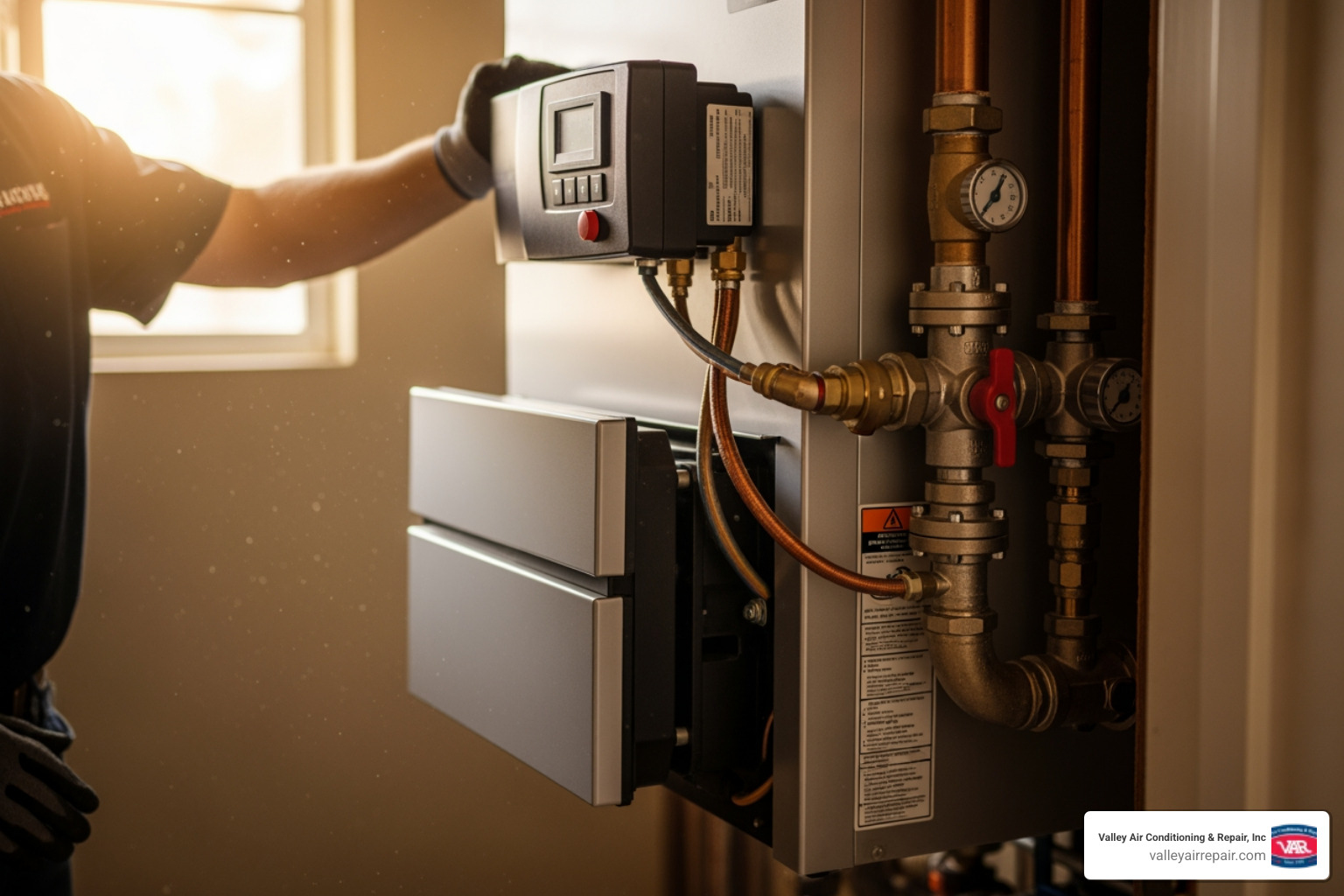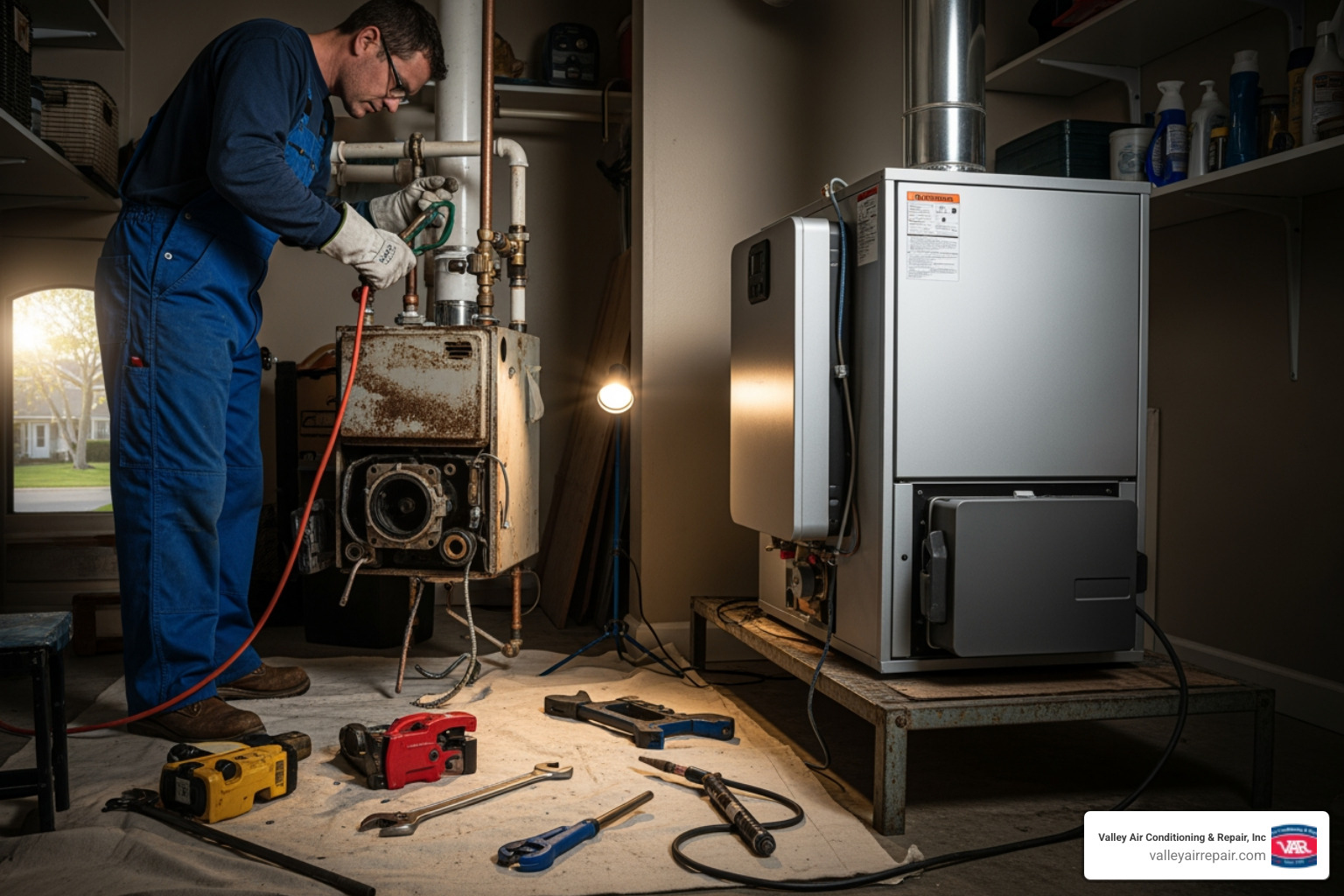Don't Sweat It: Simple Steps to Troubleshoot Your AC and Get It Running Again
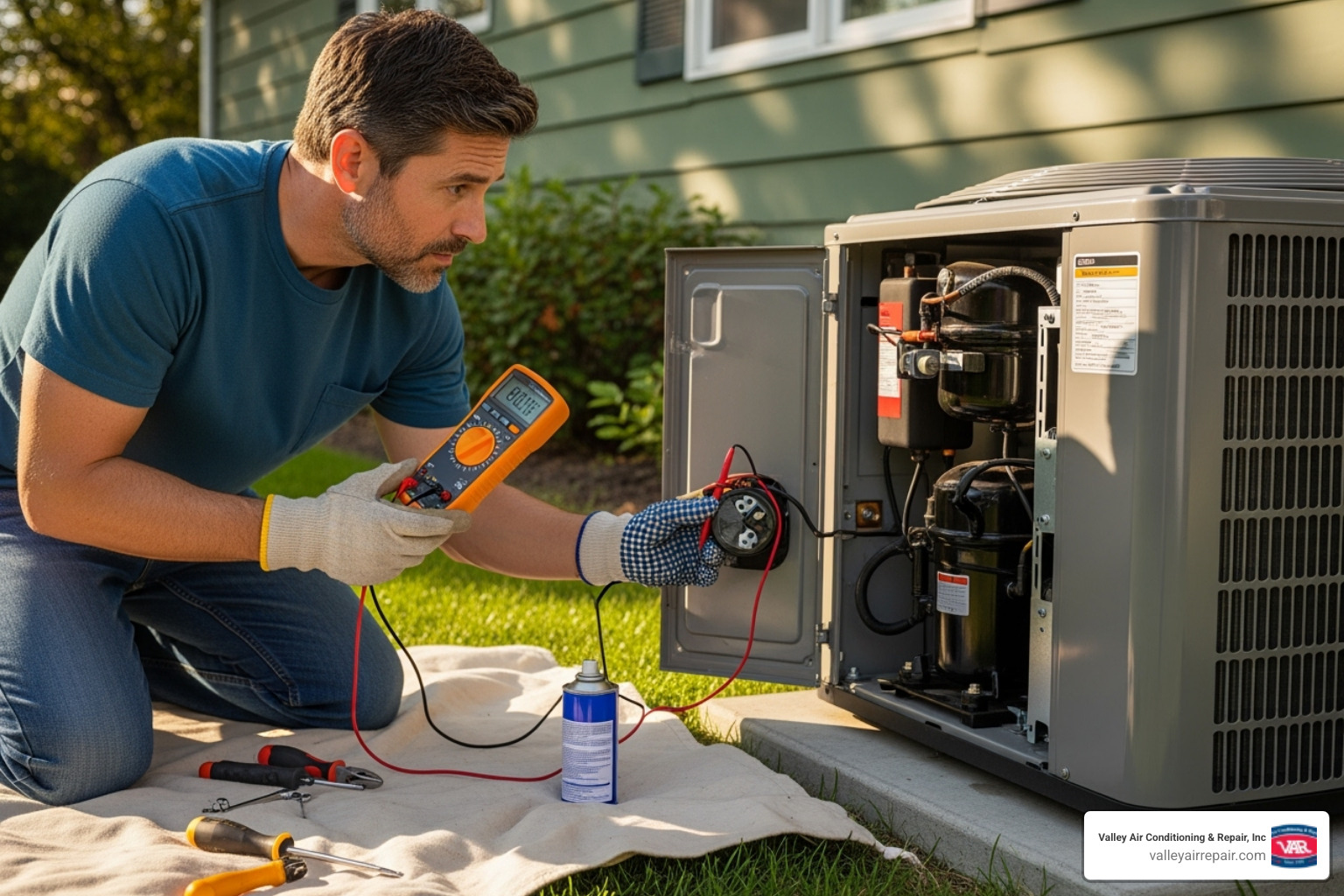
Why Every Homeowner Needs This AC Troubleshooting Guide
When your ac troubleshooting guide becomes your best friend on a sweltering summer day, you know you've hit that moment every homeowner dreads. Your AC stops working right when you need it most.
Quick AC Troubleshooting Checklist:
- Check thermostat - Set to "COOL" and temperature below room temp
- Inspect circuit breakers - Look for tripped breakers in electrical panel
- Replace air filter - Dirty filters cause 50% of AC problems
- Clear outdoor unit - Remove debris, weeds, and obstructions
- Open all vents - Closed vents can damage your system
- Listen for strange noises - Buzzing, grinding, or hissing sounds
- Look for water leaks - Turn off AC immediately if water is present
Here's the good news: many common AC issues can be identified and resolved without needing to call in a professional - saving you valuable time and money. Think about it - a typical repair visit costs around $100 per hour, but with a few household tools and basic knowledge, you might solve the problem yourself.
But here's what's even better: knowing when to stop. Some AC problems involve dangerous electrical work or refrigerant handling that requires professional expertise. This guide will teach you both - what you can safely fix yourself and when to call Valley Air Conditioning & Repair for help.
The most frustrating part? Sometimes the solution is surprisingly simple. Many service calls happen because homeowners forgot to check their thermostat settings or didn't realize their air filter was completely clogged.
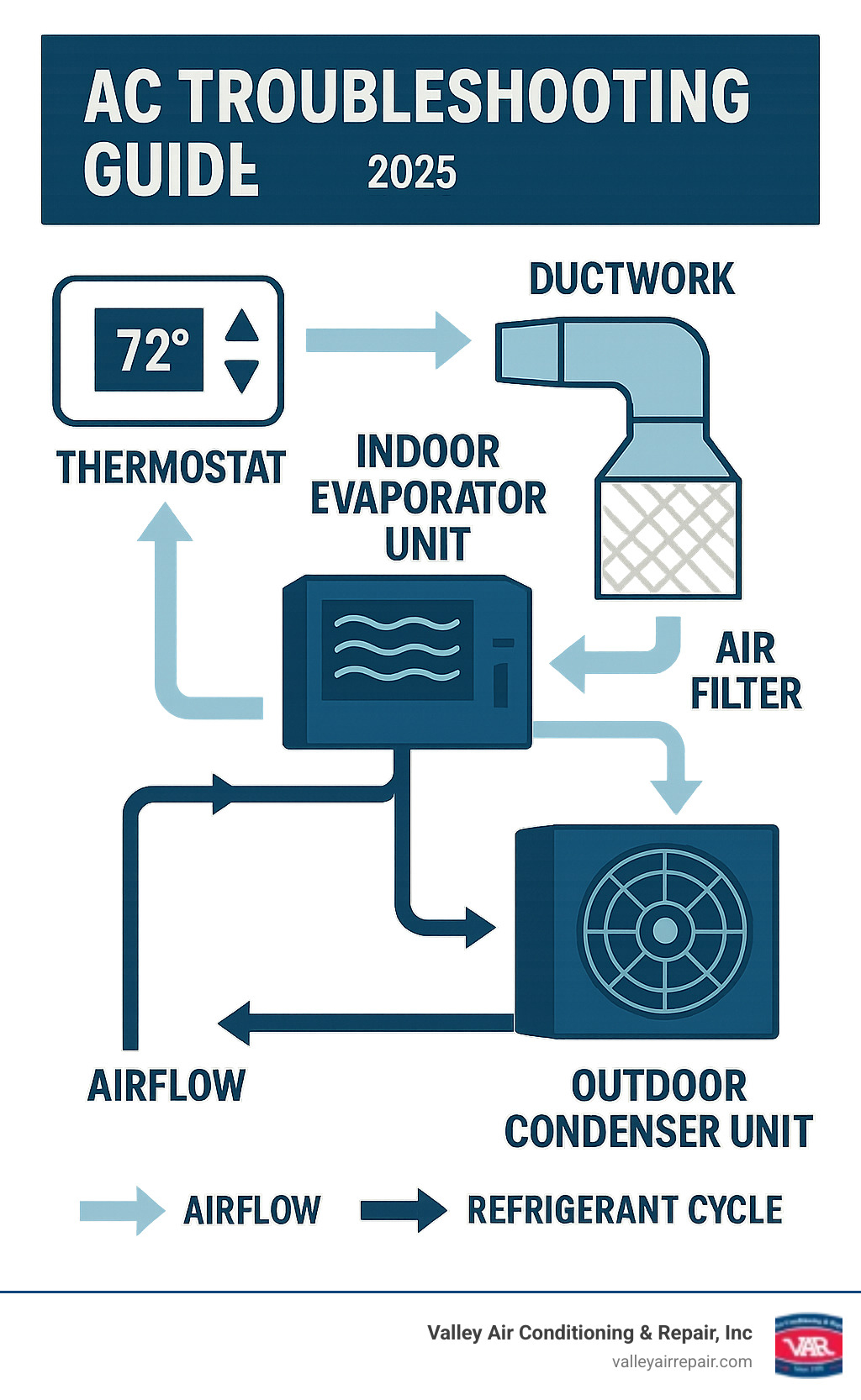
Start Here: Basic DIY AC Checks Anyone Can Do
Before assuming the worst when your AC stops working, perform a few basic checks. Many common AC problems have simple solutions you can handle yourself in minutes, saving you a service call. Start with these common culprits.
Check Your Thermostat Settings
A surprising number of AC issues stem from the thermostat. Check these settings first:
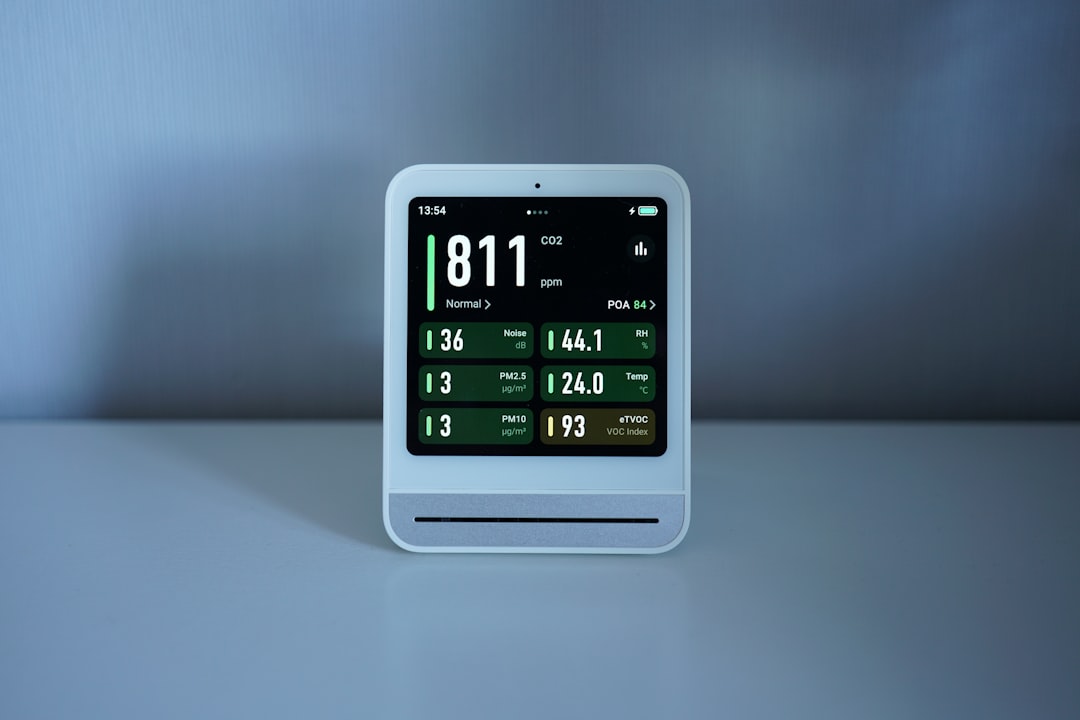
- Mode: Ensure it's set to "COOL," not "HEAT" or "OFF."
- Temperature: The set temperature must be lower than the current room temperature. Try lowering it by 5 degrees to see if the system kicks on.
- Fan: Set the fan to "AUTO." The "ON" setting runs the fan continuously, even when the air isn't being cooled.
- Batteries: If the display is dim or blank, replace the batteries.
- Schedule: Verify that a pre-programmed schedule isn't preventing the AC from running.
If the thermostat is unresponsive or reading the temperature incorrectly, you may have a sensor issue. Our guide on Troubleshooting AC Sensor Problems in Parlier can provide more insight.
Inspect the Electrical Panel
Your air conditioner can sometimes trip a circuit breaker, which is a safety measure to protect your home from an electrical overload.
Find your home's electrical panel (often in a garage or utility closet) and look for breakers labeled "AC," "Air Conditioner," or "HVAC." A tripped breaker will be positioned between "ON" and "OFF." To reset it, push the breaker firmly to "OFF" first, then flip it back to "ON."
Safety Warning: If the breaker trips again immediately, do not keep resetting it. This indicates a more serious electrical problem that requires a professional. If you're curious why your lights sometimes dim when the AC starts, check out our explanation: Why Do My Lights Dim When My AC Kicks On?
The Most Common Culprit: The Air Filter
A clogged air filter is the single most common cause of AC problems. It's also the easiest to fix.
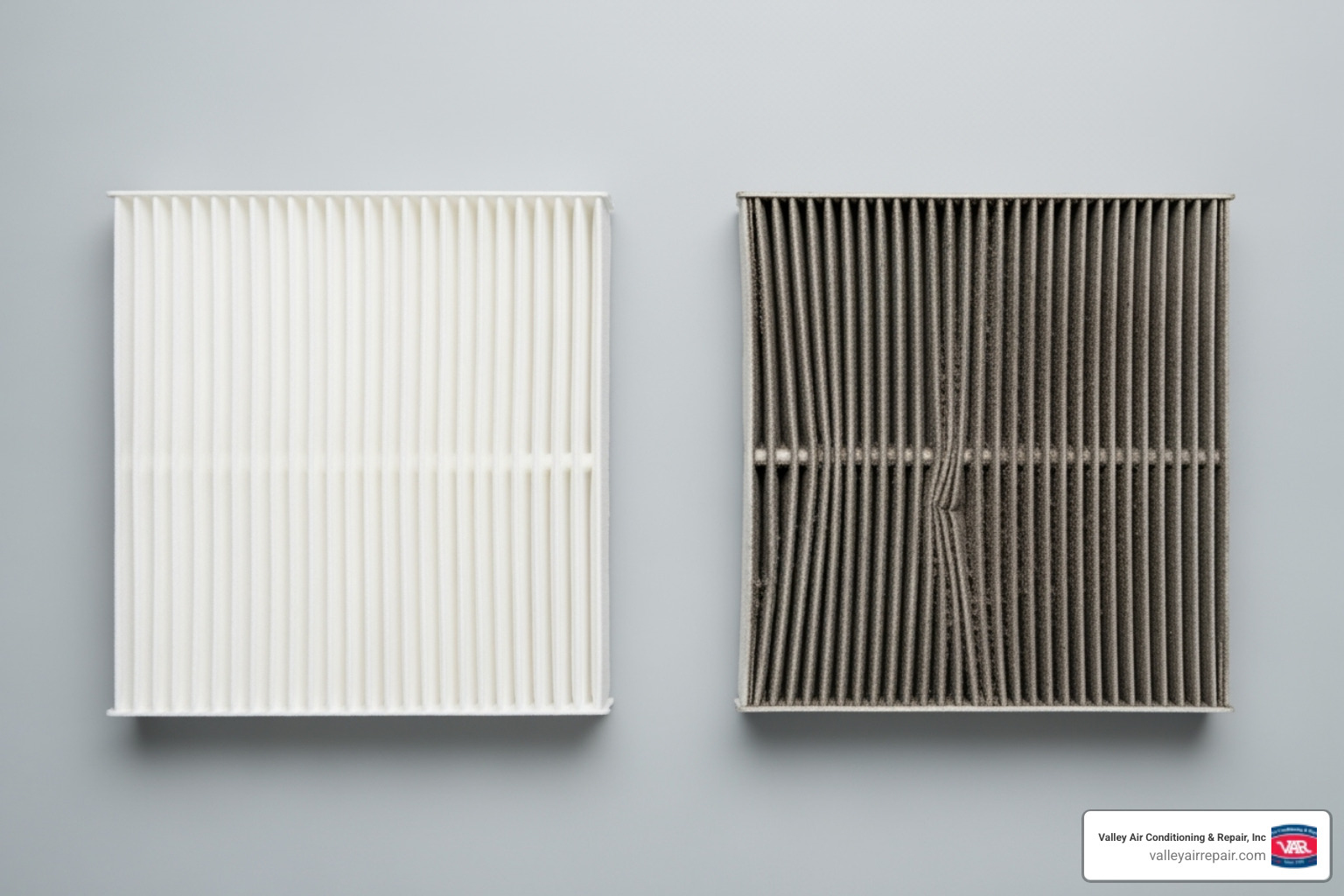
When the filter is clogged with dust and debris, it restricts airflow, forcing your system to work harder. This can lead to overheating, higher energy bills, and frozen evaporator coils.
Check your filter monthly and replace it every 1-3 months during the cooling season, or more often if you have pets or allergies. Our guide explains that filters should be replaced every three months at a minimum.
Ensure Vents and Units are Unobstructed
Proper airflow is essential for your AC system. Any blockages in the air circulation loop will cause problems.
Indoors: Walk through your home and ensure all supply and return vents are open and not blocked by furniture, rugs, or curtains. Closing vents in unused rooms is not recommended as it increases pressure in your ductwork and can lead to damage. We explain why closing vents can cause damage in our detailed post.
Outdoors: Your outdoor condenser unit needs to release the heat it pulls from your home. Clear away any leaves, weeds, or debris from the top and sides of the unit. Maintain at least 2-3 feet of clearance around the entire unit, which may require trimming back bushes and other plants.
Your Step-by-Step AC Troubleshooting Guide for Common Symptoms
Once you've covered the basics, you can use this ac troubleshooting guide to diagnose problems based on specific symptoms. Your AC system often communicates what's wrong—you just need to know what to look and listen for.
Symptom: Weak or No Airflow
If your AC is running but the airflow from vents is weak or non-existent, check these common causes:
- Clogged Air Filter: This is the most frequent cause. A dirty filter severely restricts airflow.
- Blocked or Damaged Ductwork: Check visible ducts for any crushing, disconnections, or blockages.
- Failing Blower Motor: The motor that pushes air through the ducts may be failing, leading to progressively weaker airflow. If the fan isn't working at all, see our guide on What to Do When AC Fan Stops Working.
- Frozen Evaporator Coils: Ice buildup on the indoor coil (often caused by a dirty filter or low refrigerant) can completely block air from passing through.
For more advanced solutions, see our guide on how to Fix Weak Airflow From Your HVAC Vents.
Symptom: AC is Leaking Water
Finding water around your indoor unit is a common issue. Your AC creates condensation, which normally flows away through a drain line. A leak means that system is blocked.
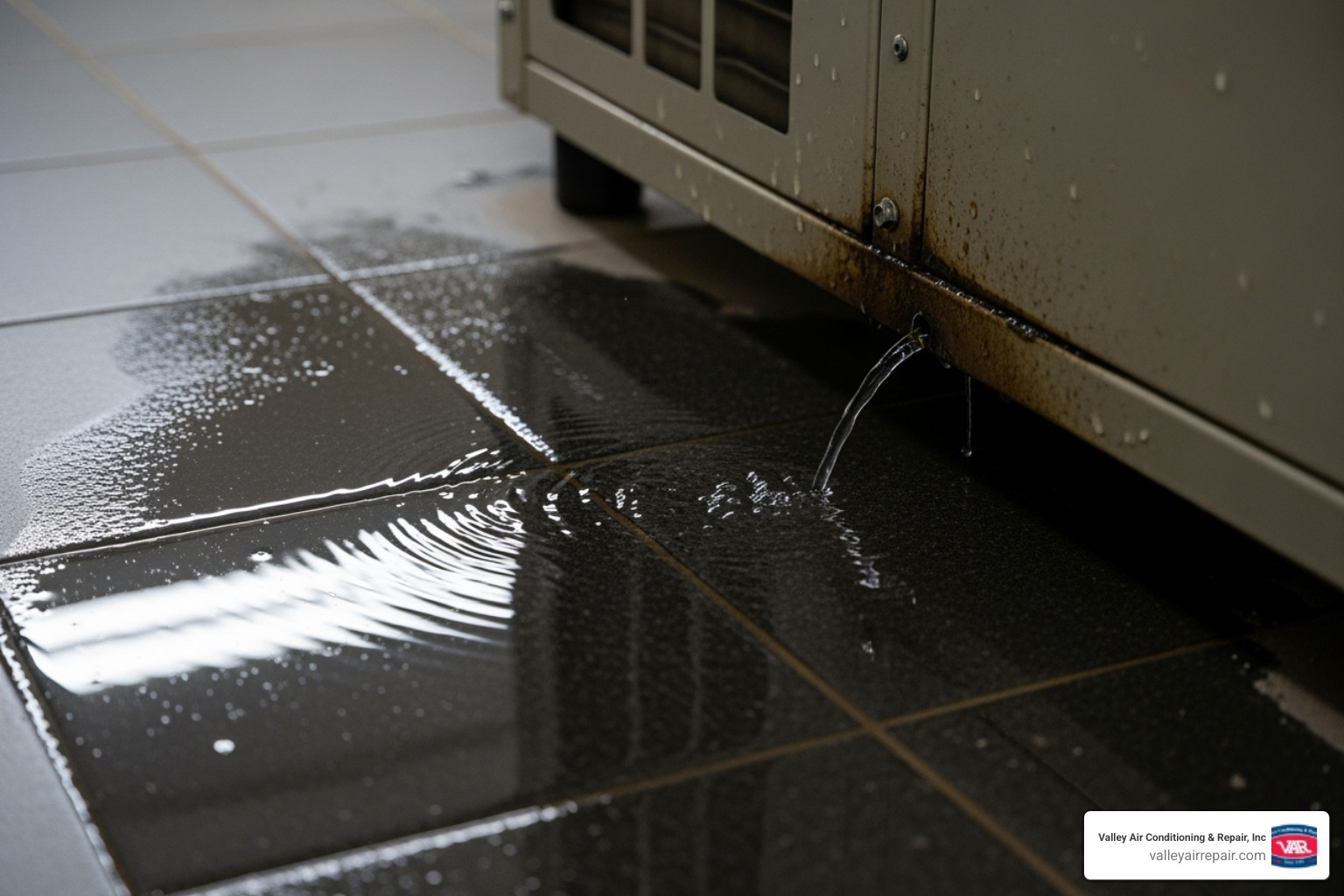
A clogged condensate drain line is the usual culprit. Algae and debris can create a blockage. You may be able to clear a minor clog yourself using a wet/dry vacuum or by carefully pouring a 50/50 vinegar and water solution down the line's access port. Our DIY drain line flush tips provide step-by-step instructions.
Another cause is frozen and thawing evaporator coils, which can release a large amount of water that overwhelms the drain pan.
Important: If you see water pooling, turn it off immediately to avoid costly water damage to your home and the unit's electrical parts. For location-specific advice, see our article Why Is My AC Leaking Water in Fresno.
Symptom: AC is Making Strange Noises
Unusual noises are your AC's way of signaling a problem. Here's what different sounds might mean:
- Buzzing or humming often points to an electrical issue, like a failing capacitor or a problem with the compressor. Our guide on Why Is My AC Making a Buzzing Noise explores this.
- Grinding sounds are a serious cry for help, typically indicating worn-out motor bearings. If you hear grinding, turn the unit off and call a professional.
- Hissing usually means a refrigerant leak or dangerously high internal pressure. A hissing sound requires immediate professional attention.
- Whistling can be caused by a severely clogged air filter or a problem with the refrigerant flow.
- Rattling is often just loose parts or debris in the outdoor unit. Check for and remove any leaves or twigs.
Symptom: AC is Blowing Warm Air or Short Cycling
These two issues often go hand-in-hand and share common causes:
- Incorrect Thermostat Settings: Double-check that the thermostat is on "COOL" and the fan is on "AUTO."
- Clogged Air Filter: A dirty filter can cause both poor cooling and short cycling by restricting airflow and causing the system to overheat.
- Low Refrigerant: A refrigerant leak will prevent the system from cooling effectively and can cause it to cycle erratically.
- Dirty Condenser Coils: If the outdoor coils are dirty, the unit can't release heat, leading to warm air and overheating.
- Oversized Unit: An AC that is too large for the space will cool the area too quickly and shut off, a process known as short cycling.
- Thermostat Location: A thermostat in direct sunlight or near a heat source can get false readings, causing the system to cycle improperly.
For a deeper look, see our resources on AC Troubleshooting Guide for warm air and Troubleshooting HVAC Short Cycling Issues for cycling problems.
Advanced Problems: When to Stop and Call a Professional
While many AC issues are simple DIY fixes, some problems require the specialized tools and safety training of a certified professional. Attempting to repair complex issues involving refrigerant handling, major electrical work, or intricate mechanical components can be dangerous, lead to more expensive damage, and may void your warranty.
Signs of a Refrigerant Leak
Refrigerant is a hazardous chemical that is regulated by the EPA, and only certified technicians are legally allowed to handle it. Never attempt to fix a refrigerant leak or recharge your system yourself. Call a professional if you notice these signs:
- Hissing or gurgling sounds from your unit.
- Ice forming on the copper refrigerant lines outside.
- The AC runs constantly but doesn't cool your home effectively.
- A sudden increase in your utility bills.
Refrigerant exposure is a health hazard, and improper handling can cause serious damage to your system. For more information, see our guides on Understanding AC Refrigerant Leaks and Solutions and Troubleshooting AC Refrigerant Pressure Issues.
Frozen Evaporator Coils
An evaporator coil covered in ice is a common but potentially damaging problem.
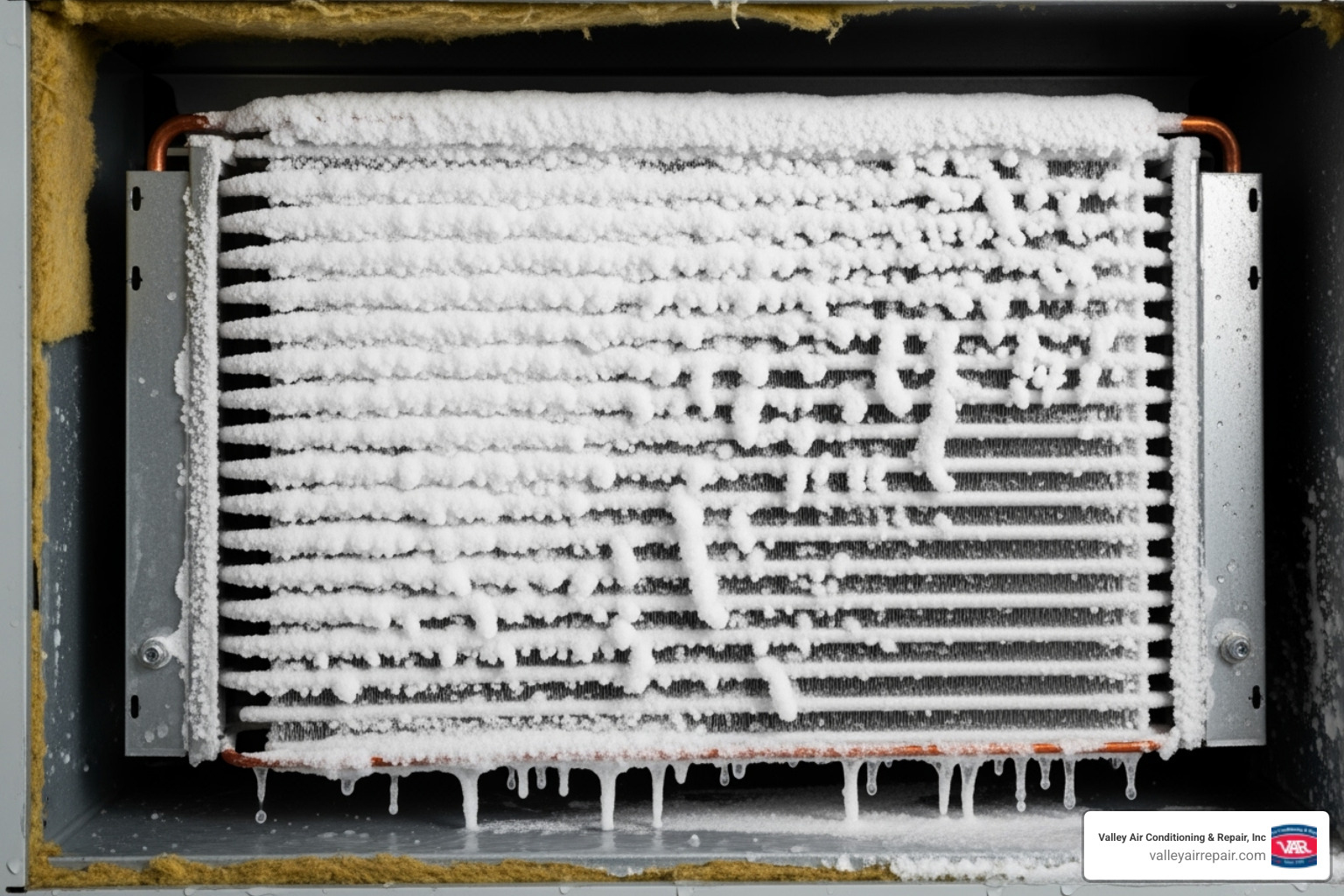
Frozen coils are usually caused by poor airflow (from a dirty filter or blocked vents) or low refrigerant levels due to a leak.
If you find ice on your coils, follow these steps:
- Turn off your AC unit immediately to prevent compressor damage.
- Set your thermostat to "FAN ONLY" to circulate air and help the ice melt faster.
- Be patient. It can take several hours for the coils to thaw completely.
Once thawed, you can replace the air filter and try turning the AC back on. If it freezes again, you have a more complex problem that needs a professional diagnosis. Our team can help you Fix a Frozen AC Evaporator Coil in Clovis.
Electrical Component Failure
Beyond a tripped breaker, your AC has several electrical parts that can fail and require professional replacement due to the risk of high-voltage shock.
- Capacitors: These components help start your system's motors. A humming sound without the unit starting is a key sign of failure. Learn the 5 Signs AC Capacitor is Failing in Madera.
- Compressor: The compressor is the heart of your AC. Loud grinding noises or a complete failure to cool are signs of a serious compressor problem. We explain What's Causing Your AC Compressor to Fail in our guide.
- Control Board: A faulty control board is like a brain malfunction, causing erratic behavior like random cycling or not responding to the thermostat.
- Condenser Fan Motor: If the fan on your outdoor unit stops spinning, the system will quickly overheat and shut down.
Attempting to replace these parts without training is dangerous and can cause further damage.
Frequently Asked Questions about AC Troubleshooting
Here are concise answers to the most common ac troubleshooting guide questions we receive from homeowners.
Why is my AC running but not cooling the house?
This common issue usually points to one of four things:
- Dirty Air Filter: A clogged filter restricts airflow, preventing cool air from circulating.
- Incorrect Thermostat Settings: Ensure the thermostat is set to "COOL" and not "FAN ONLY."
- Dirty Condenser Coils: The outdoor unit can't release heat effectively if its coils are covered in dirt and debris.
- Low Refrigerant: If the system is low on refrigerant (due to a leak), it cannot cool the air.
Check the filter, thermostat, and outdoor unit first. If these are not the issue, you likely have a refrigerant problem that requires a professional.
How do I reset my air conditioning unit?
A simple reset can often clear minor electronic glitches. Go to your home's electrical panel and find the circuit breaker for your AC unit (labeled "AC," "HVAC," etc.). Flip the breaker to the "OFF" position, wait for 5-10 minutes, and then flip it back to the "ON" position.
What causes an AC unit to turn on and off frequently?
This is called "short cycling." The most common causes are a clogged air filter causing the system to overheat, an oversized AC unit that cools the space too quickly, low refrigerant levels, or a thermostat in a poor location (e.g., in direct sunlight) that gives inaccurate readings. Checking and changing a dirty air filter is the easiest first step.
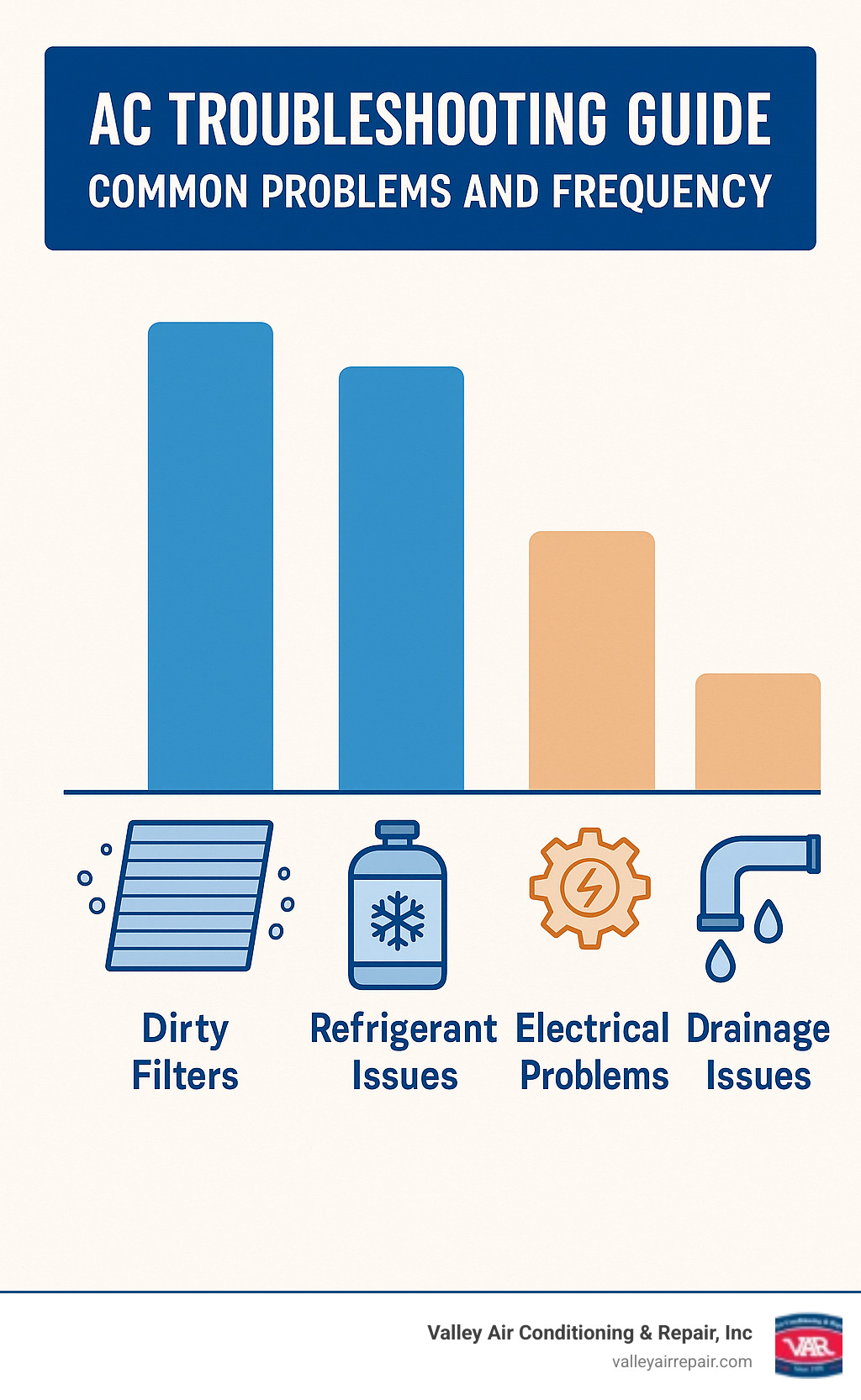
Conclusion: Stay Cool and Know When to Get Help
There you have it – your complete ac troubleshooting guide for tackling the most common air conditioning problems! We hope these steps have given you the confidence to handle simple AC issues yourself and, more importantly, helped you get back to enjoying a cool, comfortable home.
The beauty of basic AC maintenance is that many problems really do have surprisingly simple solutions. Changing a dirty air filter, adjusting your thermostat settings, or clearing debris from your outdoor unit can often solve issues that seem much more complicated at first glance. These quick fixes can save you both time and money while keeping your home comfortable during those sweltering Valley summers.
But here's what we really want you to remember: knowing when to stop is just as important as knowing what to try. Safety should always come first. When you're dealing with refrigerant leaks, complex electrical components, or persistent mechanical problems, it's time to step back and call in the professionals. These aren't just complicated fixes – they can be dangerous if handled incorrectly, and attempting them yourself might end up costing more in the long run.
Regular preventative maintenance is your best friend when it comes to avoiding major AC problems. Simple habits like checking your air filter monthly, keeping your outdoor unit clear of debris, and scheduling annual tune-ups can prevent many of the issues we've discussed in this guide. Think of it as giving your AC system the care it needs to take care of you during those hot summer months.
At Valley Air Conditioning & Repair, Inc., we've been helping Valley homeowners stay cool since 1970. Our approach has always been simple: treat every customer like family, provide honest advice, and deliver quality work you can trust. We understand how frustrating it can be when your AC stops working, especially when temperatures soar in Fresno, Clovis, Madera, and throughout the Valley.
Whether you've worked through this troubleshooting guide and still need help, or you've identified a problem that requires professional expertise, we're here for you. Our team brings decades of experience and a customer-first philosophy to every service call. We'll diagnose the issue accurately, explain your options clearly, and get your system running efficiently again.
Don't let AC problems leave you sweating! For reliable and expert AC service in Fresno, contact us today! We're always ready to help you stay cool and comfortable, no matter what your air conditioning system throws your way.




.webp)


